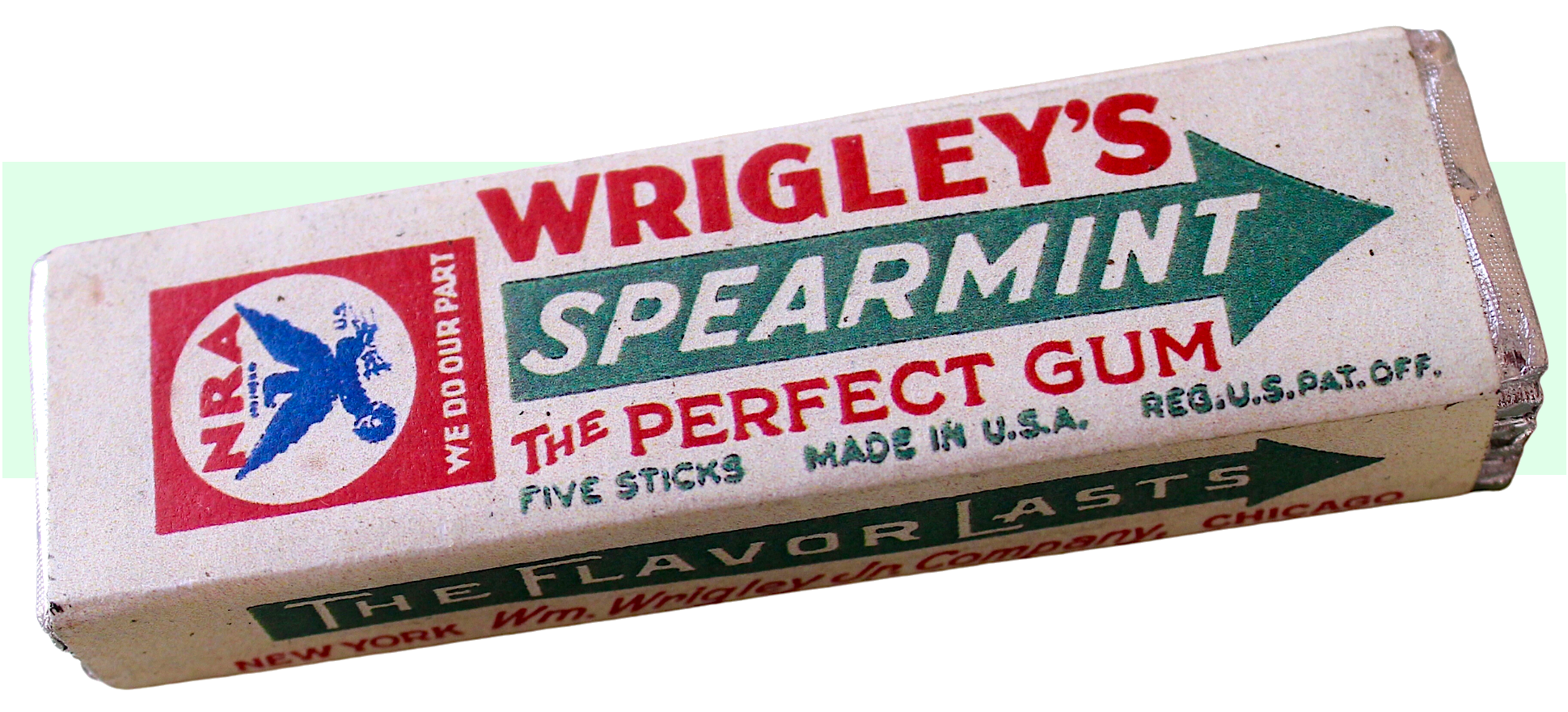
Museum Artifact: Wrigley Spearmint Gum Pack, 1932
Made By: William Wrigley Jr. Company, 3535 S. Ashland Ave., Chicago, IL [McKinley Park]
The most remarkable thing about this nearly 90 year-old pack of chewing gum cannot be gleaned from any photograph—it’s the scent! And no, it’s not the musty smell of old packaging. It’s the shockingly vibrant fragrance of the mint in these unopened sticks of Depression era Wrigley Spearmint, preserved with its self-described “air tight seal.” This is back when confectioners were still throwing all caution to the wind—using real sugar, real mint, and loads of it. As a result, this is the only artifact in the Made-In-Chicago Museum that I am tempted to put in my mouth. As they said back in the day, “The Flavor Lasts.”
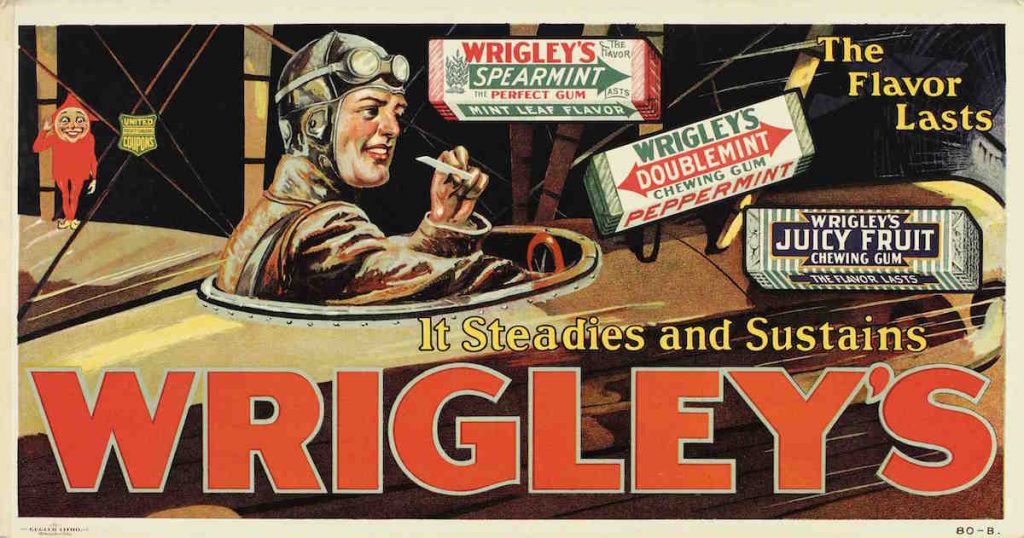
Getting past the olfactory part of the program, the second thing that stands out about our antique sample pack is the lone design element that really distinguishes it from modern day Spearmint wrappers—the big bold logo of the N.R.A. This being the 1930s, that’s the “National Recovery Administration,” not the gun folks.
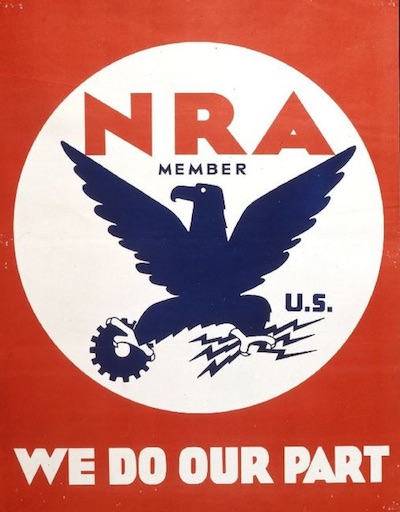 Interestingly, the listed copyright on the gum sleeve itself is 1932, but Franklin Roosevelt didn’t launch the NRA until 1933; suggesting that these “We Do Our Part” labels were tacked onto the packaging sometime after they were initially designed/printed.
Interestingly, the listed copyright on the gum sleeve itself is 1932, but Franklin Roosevelt didn’t launch the NRA until 1933; suggesting that these “We Do Our Part” labels were tacked onto the packaging sometime after they were initially designed/printed.
At the time, company president Philip K. Wrigley was a fan of both FDR and the NRA, and proudly supported the cause. He likely also related to Roosevelt’s challenging job stepping in as a new leader in trying times. Wrigley’s famous father and company founder William Wrigley, Jr., died in 1932, transitioning the massive gum empire over to Philip.
Phil Wrigley is probably best remembered historically as the moneyman behind the All-American Girls Baseball League during World War II (as popularized in the film A League of Their Own), but he was also a very progressive and popular businessman who really cemented the legacy of his father’s company—and arguably the reputation of his baseball team (for better or worse).
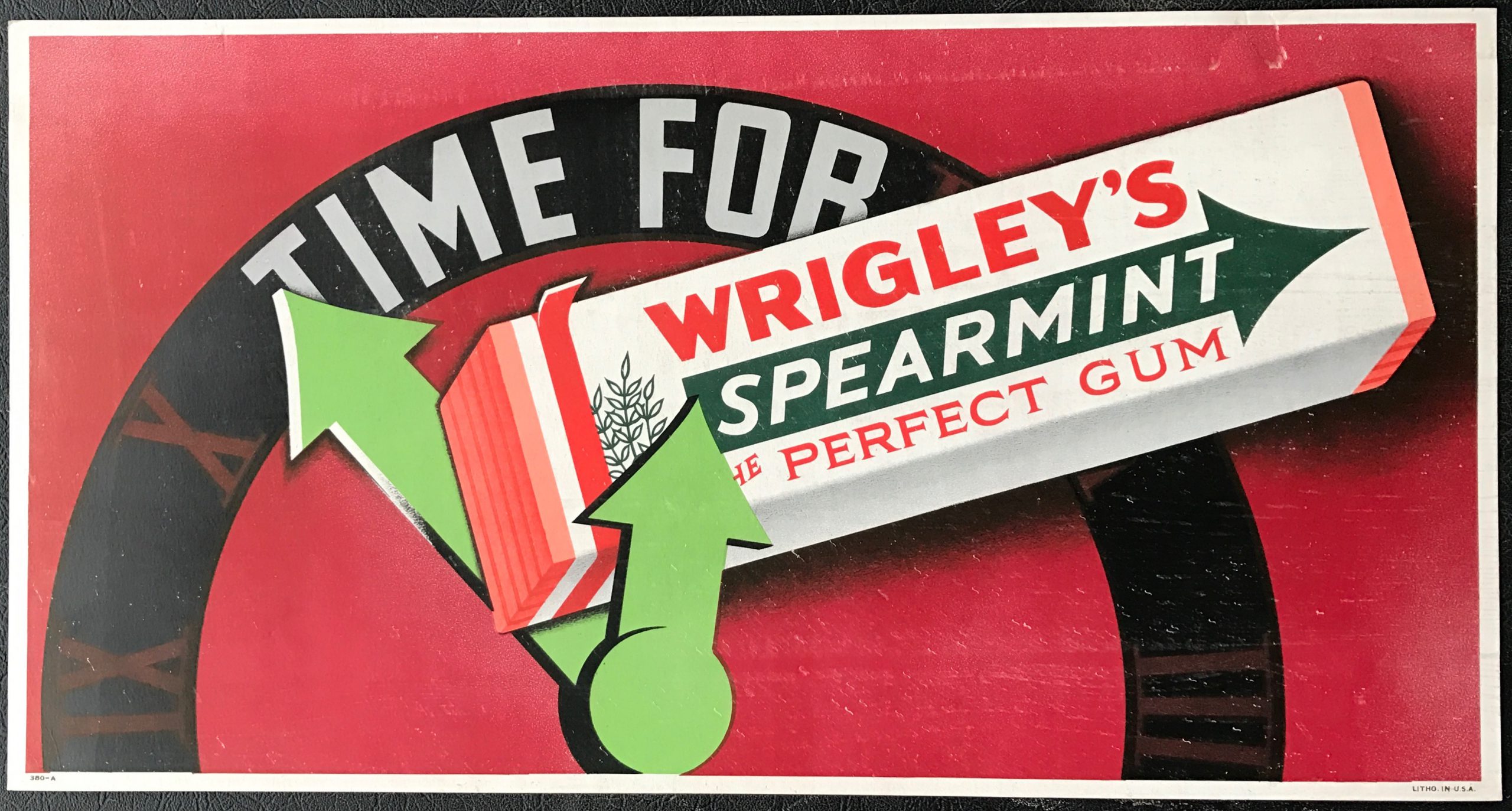 [This vintage 1930s era trolley sign advertisement, measuring about 18″ long, is also part of the Made-In-Chicago Museum’s collection]
[This vintage 1930s era trolley sign advertisement, measuring about 18″ long, is also part of the Made-In-Chicago Museum’s collection]
The Son
Philip Wrigley [pictured below] was born in 1894, just a year after his dad sold his first stick of gum. By the age of 20, Phil had joined the family business, running the company’s first plant in Australia. He came back to enlist in the Navy, and studied mechanics at the Great Lakes Naval Training Station, where he likely crossed paths with a couple other mechanically minded chaps, future Zenith Corp founders Karl Hassel and Ralph Matthews.
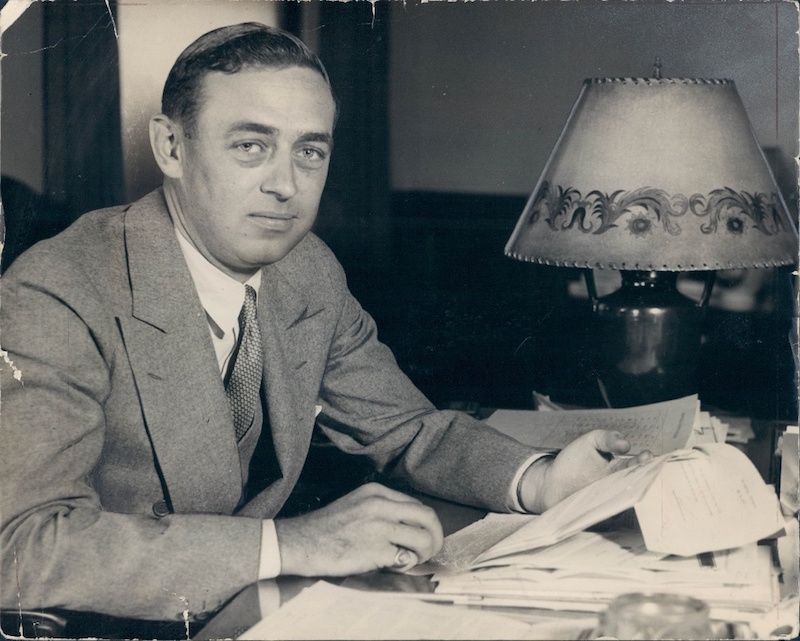
When pushed into leadership in his late 30s, Philip earned respect for keeping gum prices low regardless of the economy’s ups and downs. He also transitioned his dad’s famous marketing campaigns into emerging radio markets; helped to sustain one of the country’s first five-day work weeks; and installed employee benefit packages that kept his team in good spirits even during some of the roughest years of the Depression.
1932 was also Philip Wrigley’s first year as owner of the Chicago Cubs—his father had gained majority ownership of the club in 1921. The Cubbies were eventually swept in the ’32 World Series by the Yankees, and over the remaining 45 years of Phil’s life, the North Siders famously never won a championship. This was certainly partially a consequence of Phil’s philosophy on selling the fans on “the experience” of attending a ballgame, rather than investing in the components necessary for winning.
“Our idea in advertising the game,” he once said, “the fun, and the healthfulness of it, the sunshine and the relaxation, is to get the public to see ball games, win or lose.” To that end, Wrigley certainly succeeded.
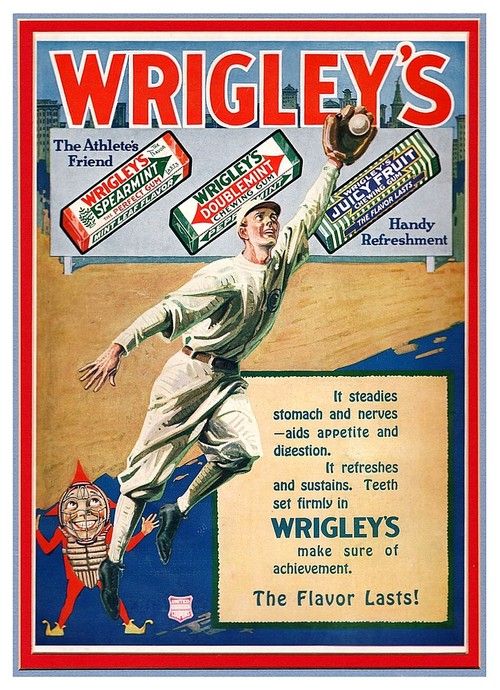
The Father
Phil Wrigley’s approach to marketing the Cubs certainly proves he was a chip off the old block. His father, William Wrigley Jr., was largely responsible for bringing direct marketing and large-scale advertising campaigns into the 20th century. This aggressive self-promotion helped turn a soap salesman from Philadelphia into one of the unlikely icons of both the city of Chicago and the chewing gum industry. Sometimes, though, it was actually a strategic sense of restraint—and a willingness to pivot—that endeared William Wrigley to the public, and kept his product from reaching obnoxious over-saturation.
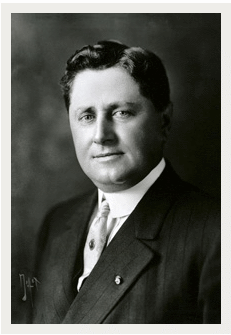
When the spectacular south tower of the 425-foot tall Wrigley Building (400 N. Michigan Ave.) was completed in 1921, for example, William asked a reporter, “Did you find my name anywhere on this building? Did you find any mention of Spearmint on its outside walls? People thought when I began to put this up that I would plaster my name all over it in letters big enough to be seen miles away. If you look when you go out you will find it in small letters over the front door—but you may have to look twice,” he chuckled.
“As a matter of fact, it was better advertising not to plaster my name on the building. People talk more about it. It is the unusual thing—the thing they didn’t expect me to do.”
As author S.J. Duncan-Clark noted when profiling Wrigley for Illustrated World in 1922, much of the chewing gum magnate’s success had something to do with his ability to combine “the practical and the idealistic; actuality and imagination.”
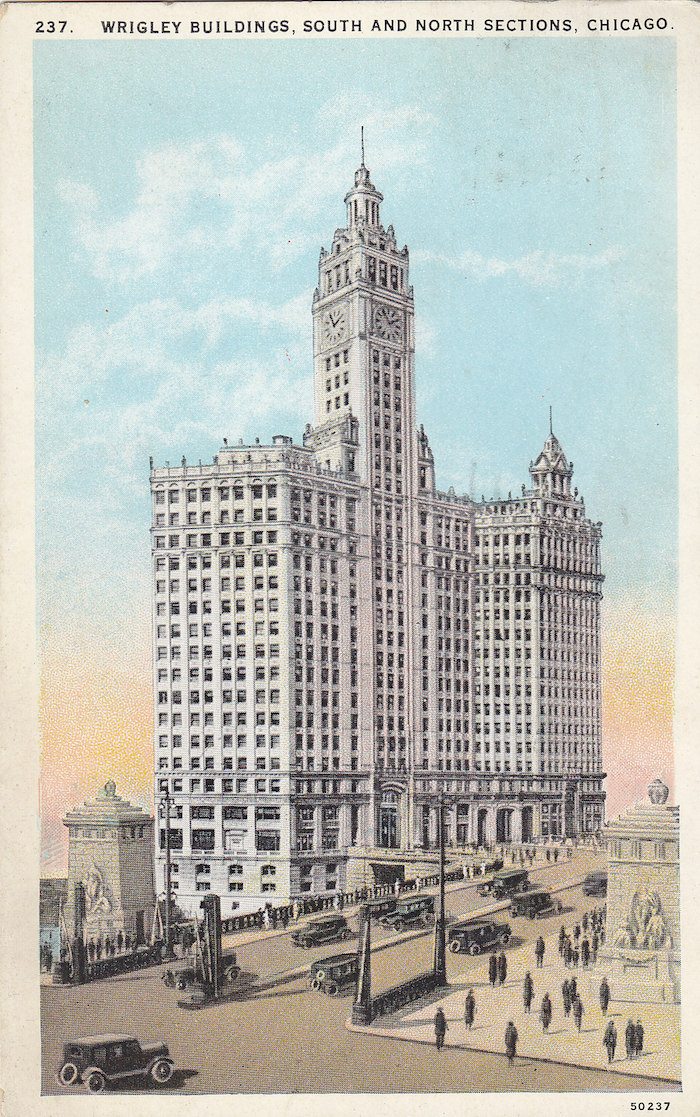 “The [Wrigley Building] is the substantial actuality commanding attention everywhere,” Clark wrote, “but it was imagination approaching genius which saw there was more to be gained by allowing it to tell its own story than by turning it into a billboard.”
“The [Wrigley Building] is the substantial actuality commanding attention everywhere,” Clark wrote, “but it was imagination approaching genius which saw there was more to be gained by allowing it to tell its own story than by turning it into a billboard.”
Ironically, nearly a century later, the Wrigley Building stands in stark contrast to its new next-door neighbor on the north bank of the Chicago River, the Trump Tower—widely known, and derided locally, for its 20-foot tall glowing name tag.
Wrigley was no less of a showman than Donald Trump in many respects, but he seemed to look at self-promotion more like a necessary engine of the larger machine, rather than a statement of conquest. “Advertising is pretty much like running a furnace,” he said. “You’ve got to keep on shoveling coal. Once you stop stoking, the fire goes out.”
Yes, he did also change the name of Cubs Park to Wrigley Field in 1927, but the fact that the stadium still has that name more than 30 years after the Wrigley family sold it indicates just how successful William Wrigley’s style of self-promotion really was. Beyond baseball, beyond businessmen, beyond gum companies—“Wrigley” just came to be associated with good feelings.
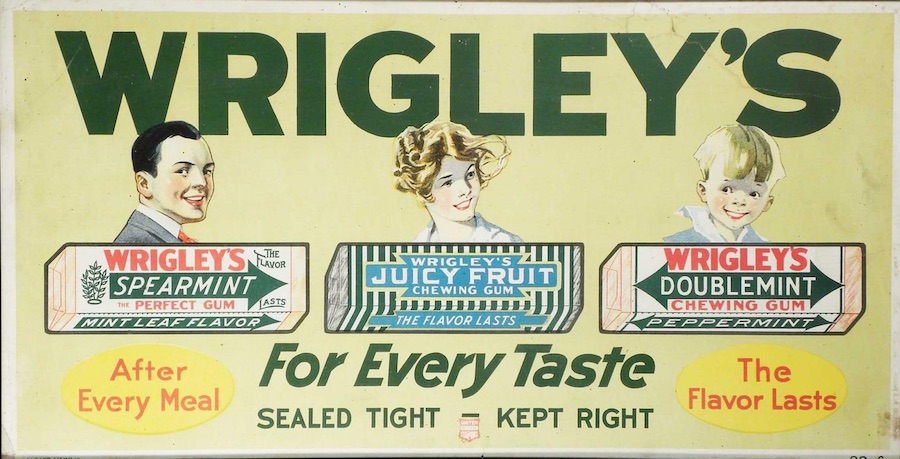
“Life and business are rather simple after all,” Wrigley explained in a 1920 issue of American Magazine. “To make a success of either, you’ve got to hang on to the knack of putting yourself in the other fellow’s place . . . If I’ve accomplished anything worthwhile, that’s the whole blooming secret of it.
Wrigley had an equally simplistic business mantra: “Make a good product for a fair price, then tell the world.” It was something he learned while still a kid on the streets of Philadelphia.
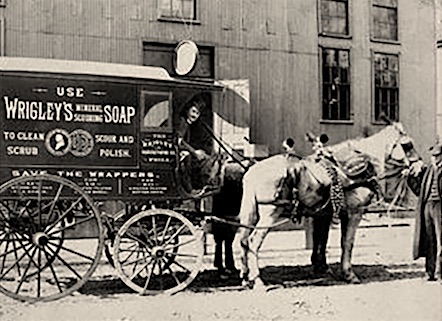 A troublemaker and grade school dropout, Wrigley started working as a salesman for his father’s soap factory by age 13—giving him a crash course in listening to customers and crafting a message custom tailored to each individual. He also learned the sales tactic of the “incentive” or “premium”—offering a throw-in gift with the main product to coax a purchase.
A troublemaker and grade school dropout, Wrigley started working as a salesman for his father’s soap factory by age 13—giving him a crash course in listening to customers and crafting a message custom tailored to each individual. He also learned the sales tactic of the “incentive” or “premium”—offering a throw-in gift with the main product to coax a purchase.
“In the spring of 1891 [age 29], I came to Chicago with thirty two dollars and my experience,” Wrigley recalled—a story which has become part of company mythology. “I rented desk room in an office on East Kinzie Street, and tried to sell more soap to Chicago. It was hard going for a while. Then I hit on the notion of offering the merchant the premium of an umbrella with every box of soap, raising the retail price to ten cents a cake and giving him at the same time a bigger margin of profit. It worked.”
 [Excerpt from the 1891 book Chicago and Its Resources 20 Years After, discussing the upstart Wrigley business before chewing gum was even involved]
[Excerpt from the 1891 book Chicago and Its Resources 20 Years After, discussing the upstart Wrigley business before chewing gum was even involved]
From there, a comedic series of events unfolded in which each subsequent premium item that Wrigley offered ended up more popular than his main product. First he switched from soap to baking powder, then—when customers loved the sticks of chewing gum he offered with the baking powder—he switched gears again: a billion dollar decision.
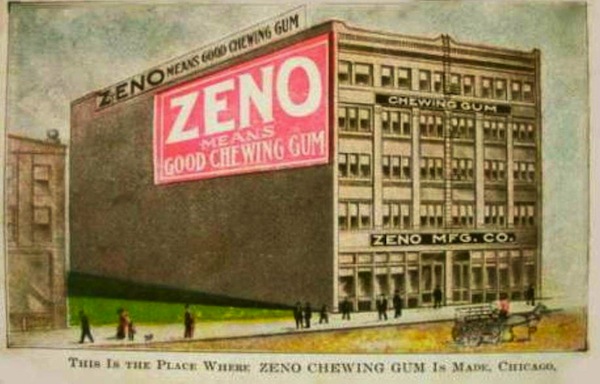 For nearly 20 years, Wrigley was really more of a distribution man, focusing on ad campaigns, display strategies for merchants, and incentive packages for prospective gum dealers (many Wrigley candy scales were produced for this purpose, likely manufactured—based on the designs—by Chicago’s American Cutlery Company). He took enormous risks throwing piles of money at billboards and magazine advertising across the country. Meanwhile, all Wrigley gum, including the popular Spearmint, Juicy Fruit, and Doublemint brands, were manufactured by Chicago’s Zeno Gum Company, as they had been from the beginning.
For nearly 20 years, Wrigley was really more of a distribution man, focusing on ad campaigns, display strategies for merchants, and incentive packages for prospective gum dealers (many Wrigley candy scales were produced for this purpose, likely manufactured—based on the designs—by Chicago’s American Cutlery Company). He took enormous risks throwing piles of money at billboards and magazine advertising across the country. Meanwhile, all Wrigley gum, including the popular Spearmint, Juicy Fruit, and Doublemint brands, were manufactured by Chicago’s Zeno Gum Company, as they had been from the beginning.
This finally changed in 1911, when Wrigley purchased Zeno outright and established the Wm. Wrigley Jr. Company. From there, a new factory at 35th and Ashland Avenue—located in Chicago’s booming Central Manufacturing District—became
Wrigley’s left arm, while the skyscraper built in the 1920s became his right. The Wrigley Company had numerous other plants across the world, but that legendary factory at 3535 S. Ashland Ave. remained the hub and heart of the operation through the entirety of the 20th century.
“We are turning out nearly ten billion sticks of gum a year,” Wrigley said in 1921. “They tell me our four plants turn out enough gum every day to reach from New York to Galveston and pretty nearly bridge the Gulf of Mexico if the sticks were laid end to end.”
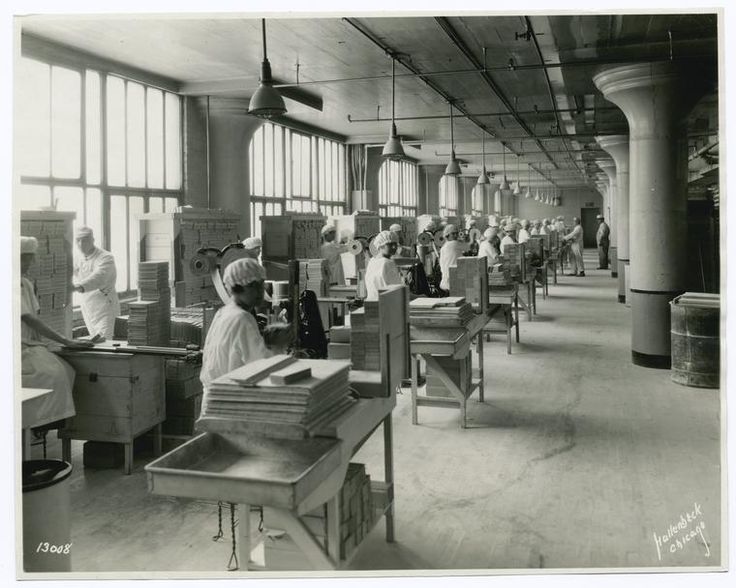 [Workers at the Wrigley, formerly Zeno, Gum Factory, circa 1912]
[Workers at the Wrigley, formerly Zeno, Gum Factory, circa 1912]
The Great Grandson
When the Ashland Avenue plant was finally shuttered in 2005, it ended more than a century of Wrigley gum production in the Chicago city limits. The decision to move on was made by William Wrigley’s great grandson, confusingly also named William Wrigley, Jr. (the first William Jr. begat Philip who begat another William who begat another William Jr.).
“While this is a difficult decision for me personally,” the current Mr. Wrigley announced, “we would not be making this choice if we did not believe that this change was absolutely necessary for the long-term vitality of our company.”
After sitting empty for nearly a decade, the Ashland factory started undergoing demolition in 2014.
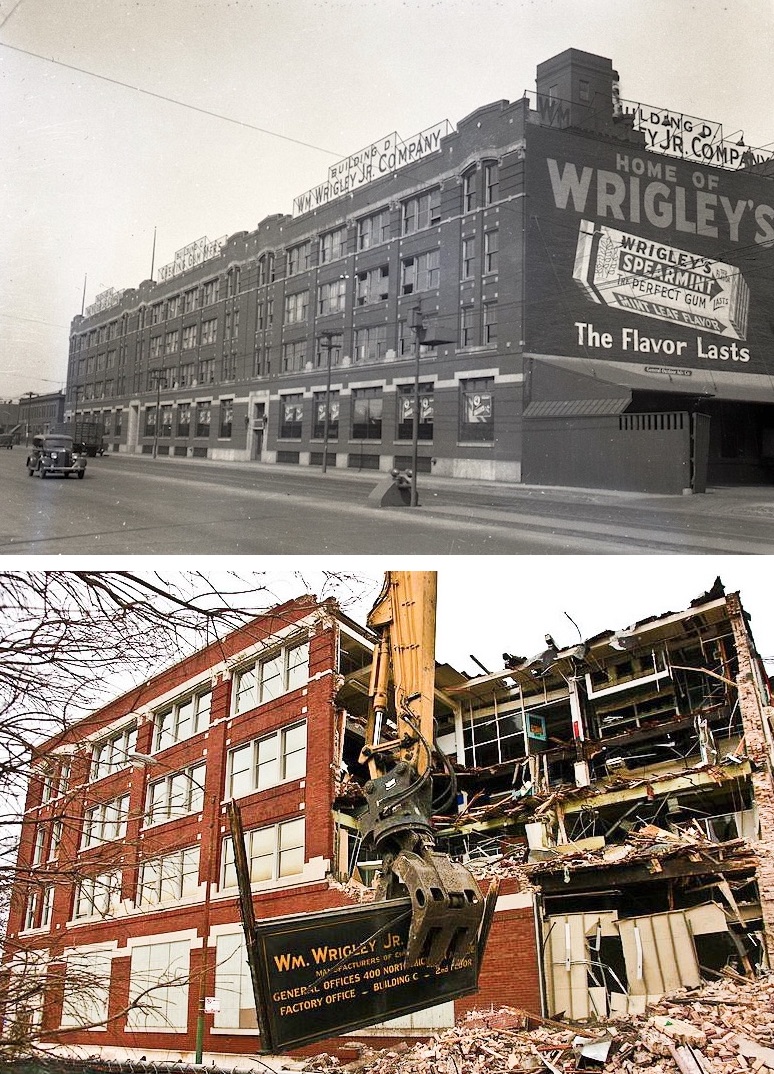 [The Wrigley Gum factory at 3535 S. Ashland Ave., thriving in 1933 (roughly the year our vintage Spearmint pack was made) and in the process of demolition in 2016]
[The Wrigley Gum factory at 3535 S. Ashland Ave., thriving in 1933 (roughly the year our vintage Spearmint pack was made) and in the process of demolition in 2016]
As the old Wrigley slogan goes, “The Flavor Lasts.” And while you could argue that “industry doesn’t,” the Wrigley Company hasn’t abandoned Chicago as many others have. Its new official corporate headquarters is located on Goose Island, known as the Global Innovation Center. The company, which is now a subsidiary of Mars Inc., also still owns the Wrigley Building downtown and several other facilities. As of 2012, they employ about 1,000 people in the city.
“There you have the story,” William Wrigley said in 1922. “There is no rule in this game except to use the best judgment you have, think hard, act quickly, and remember the other fellow has as good a right to live as you.”
When asked what his greatest achievement or legacy was, though, William pointed not to any factories, skyscrapers, or mansions, but to his son Philip.
“Any man with money can put up a building,” he said. The rest was implied with a smile.
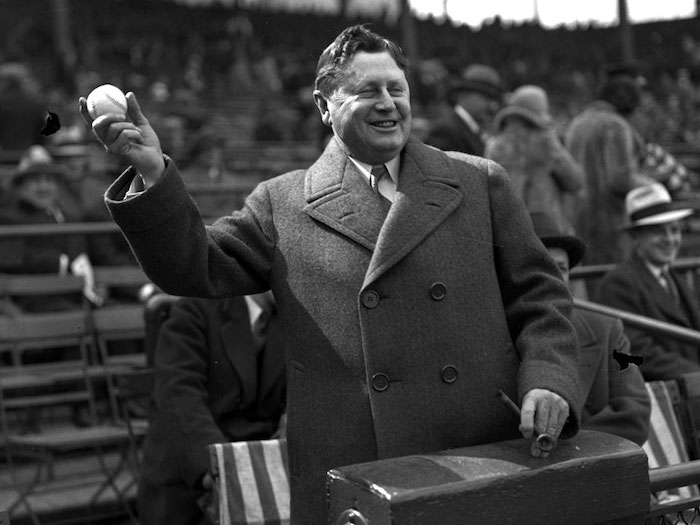
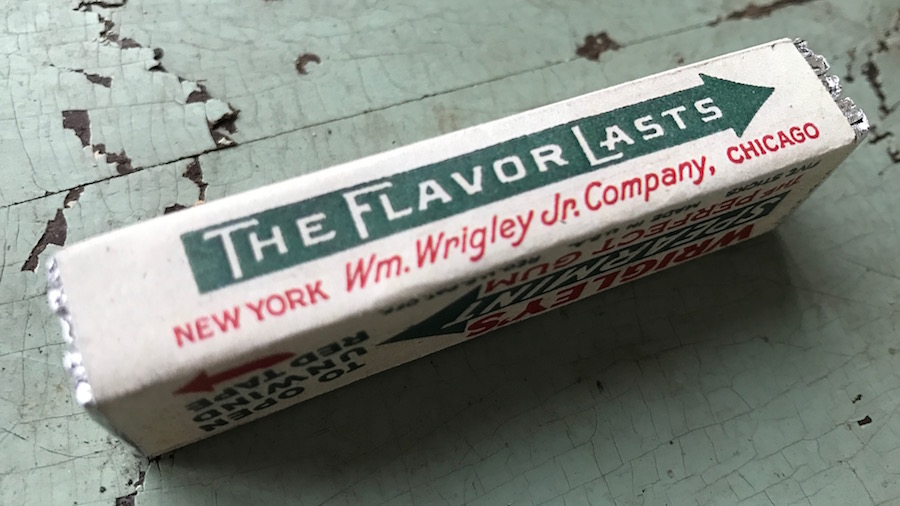
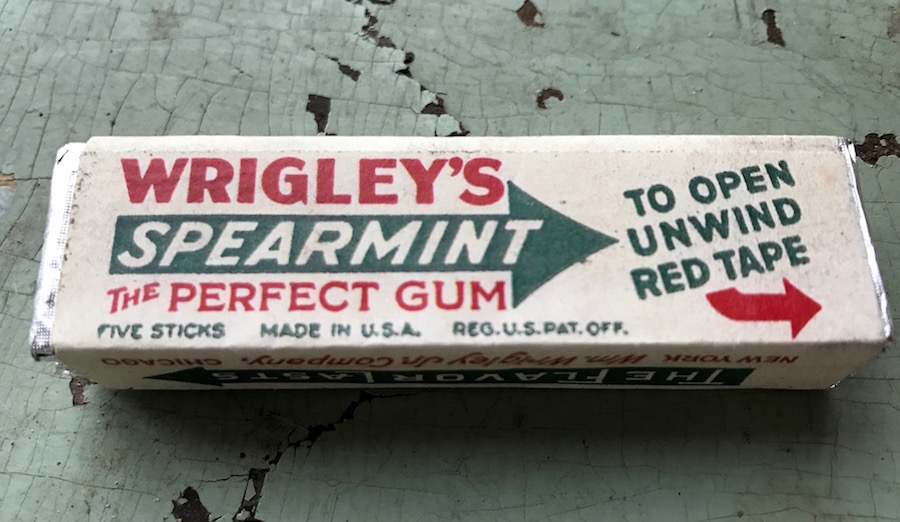
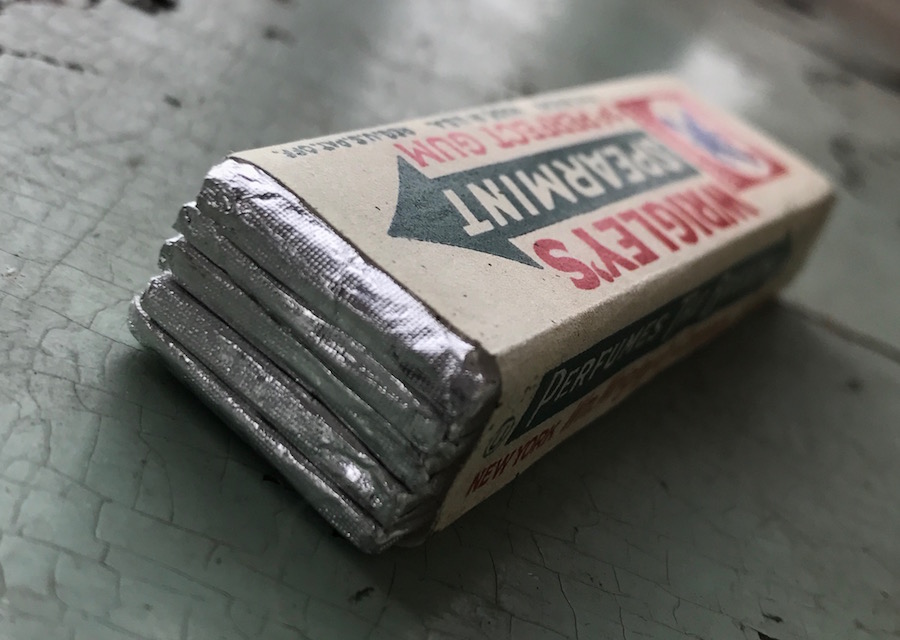
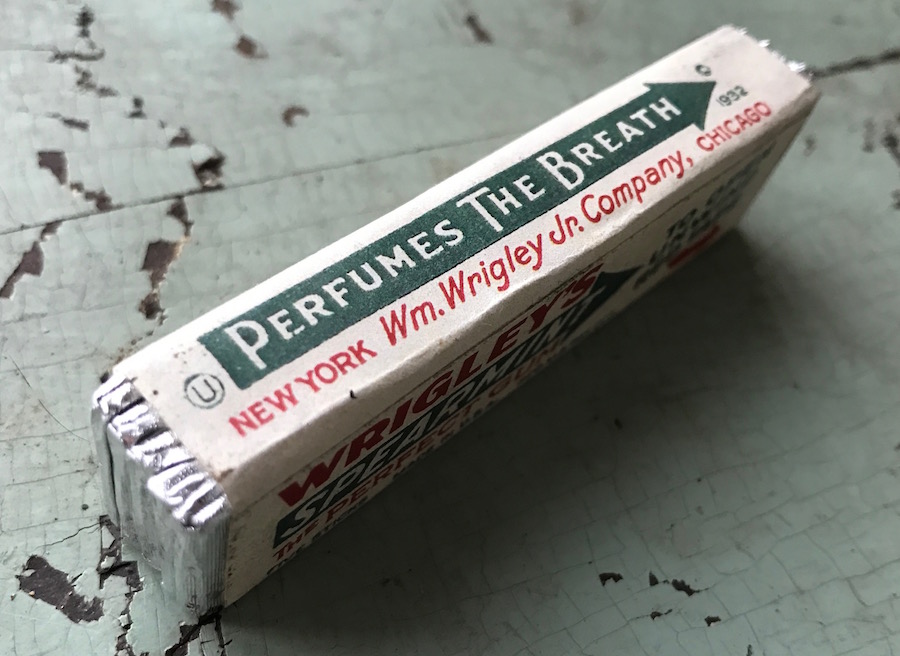
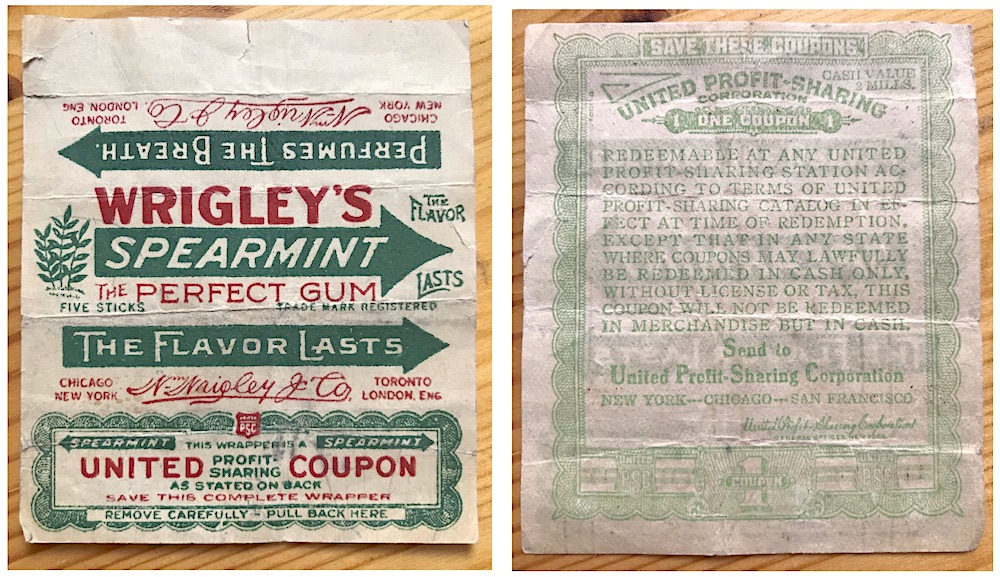
[Above and Below: 1920s Wrigley Spearmint and Wrigley Juicy Fruit gum wrappers from our museum collection. These wrappers doubled as coupons for the United Profit Sharing Corporation]
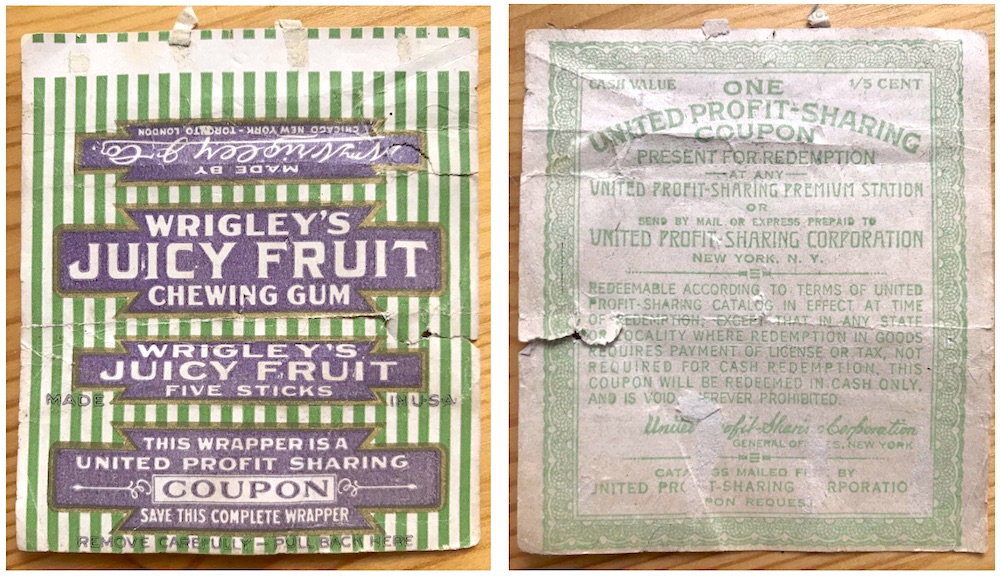
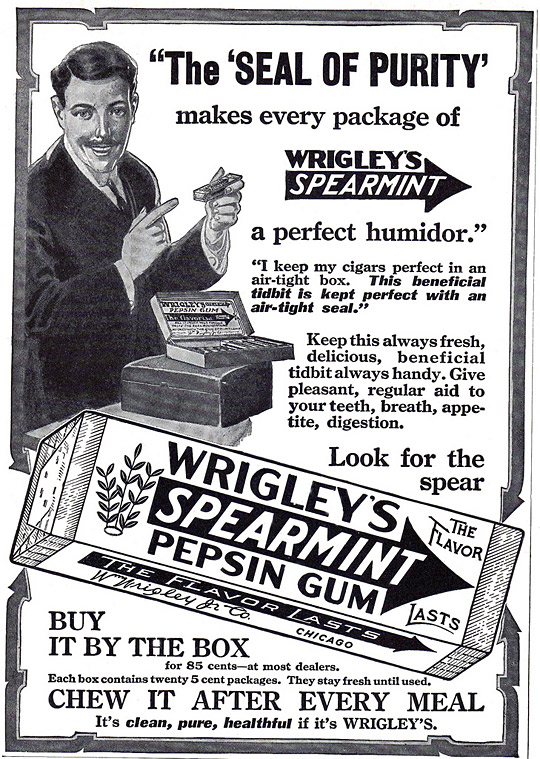
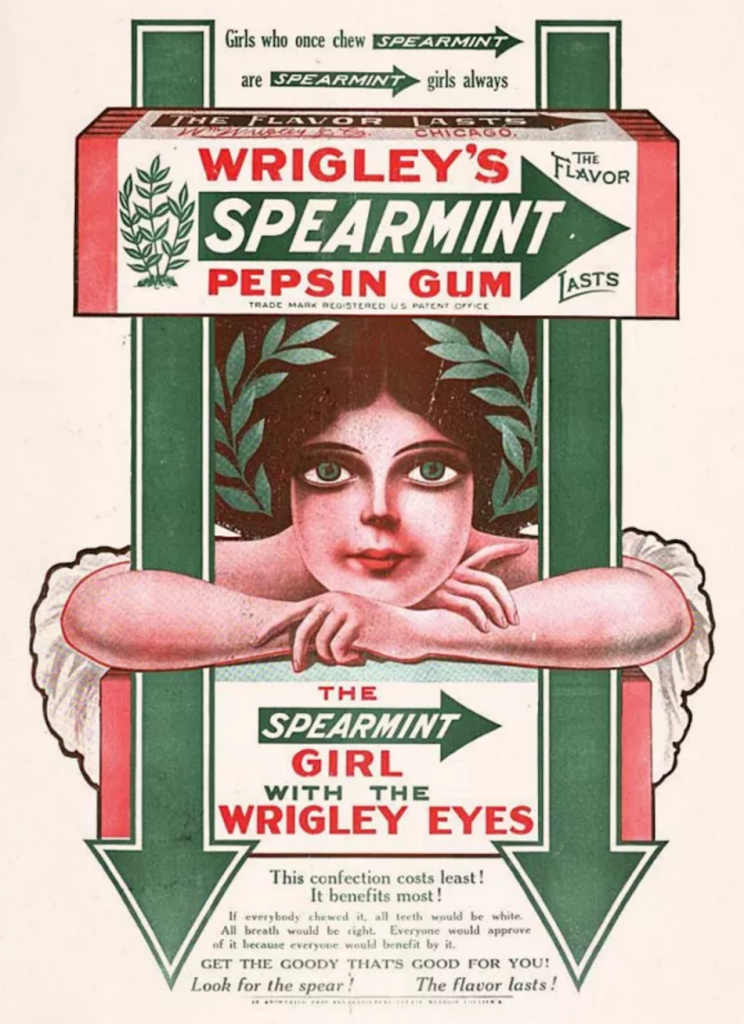
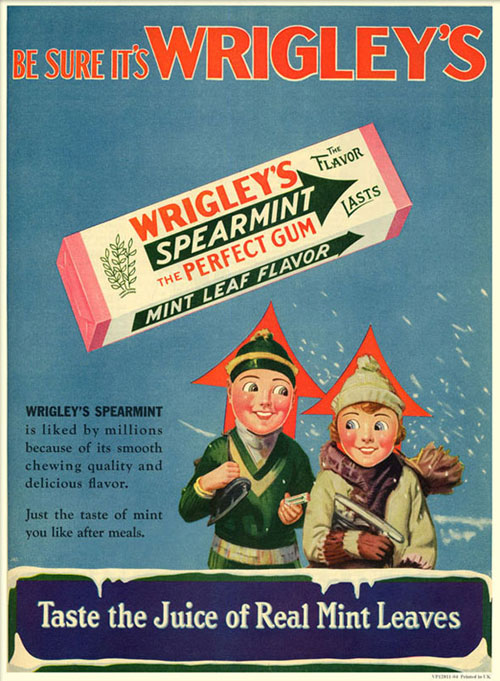
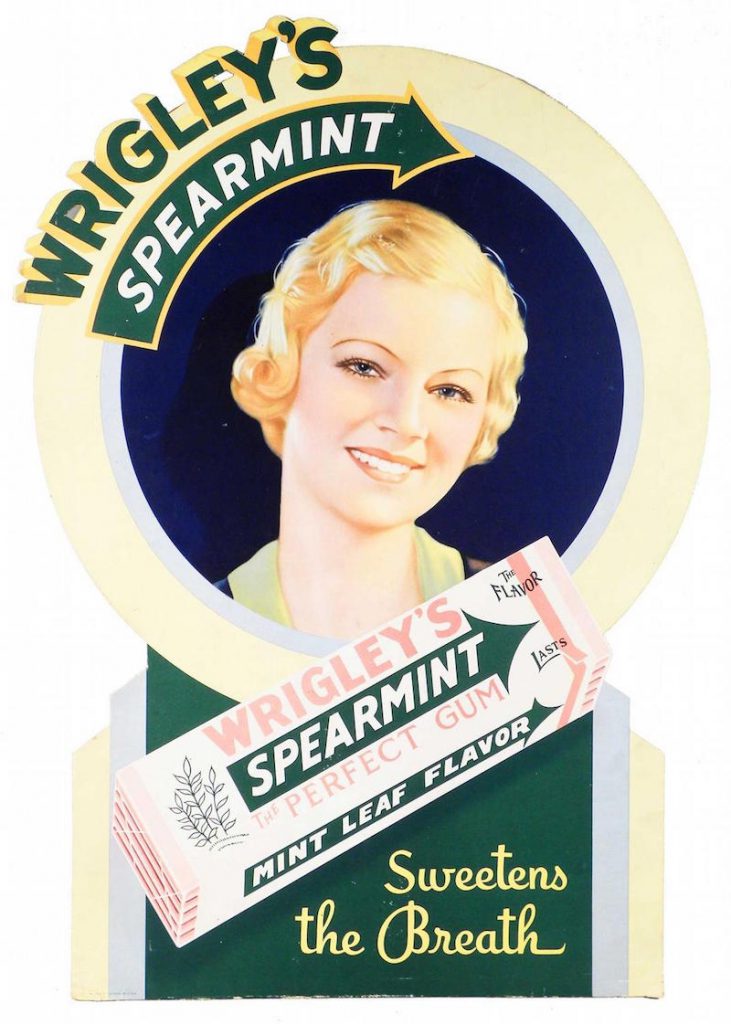
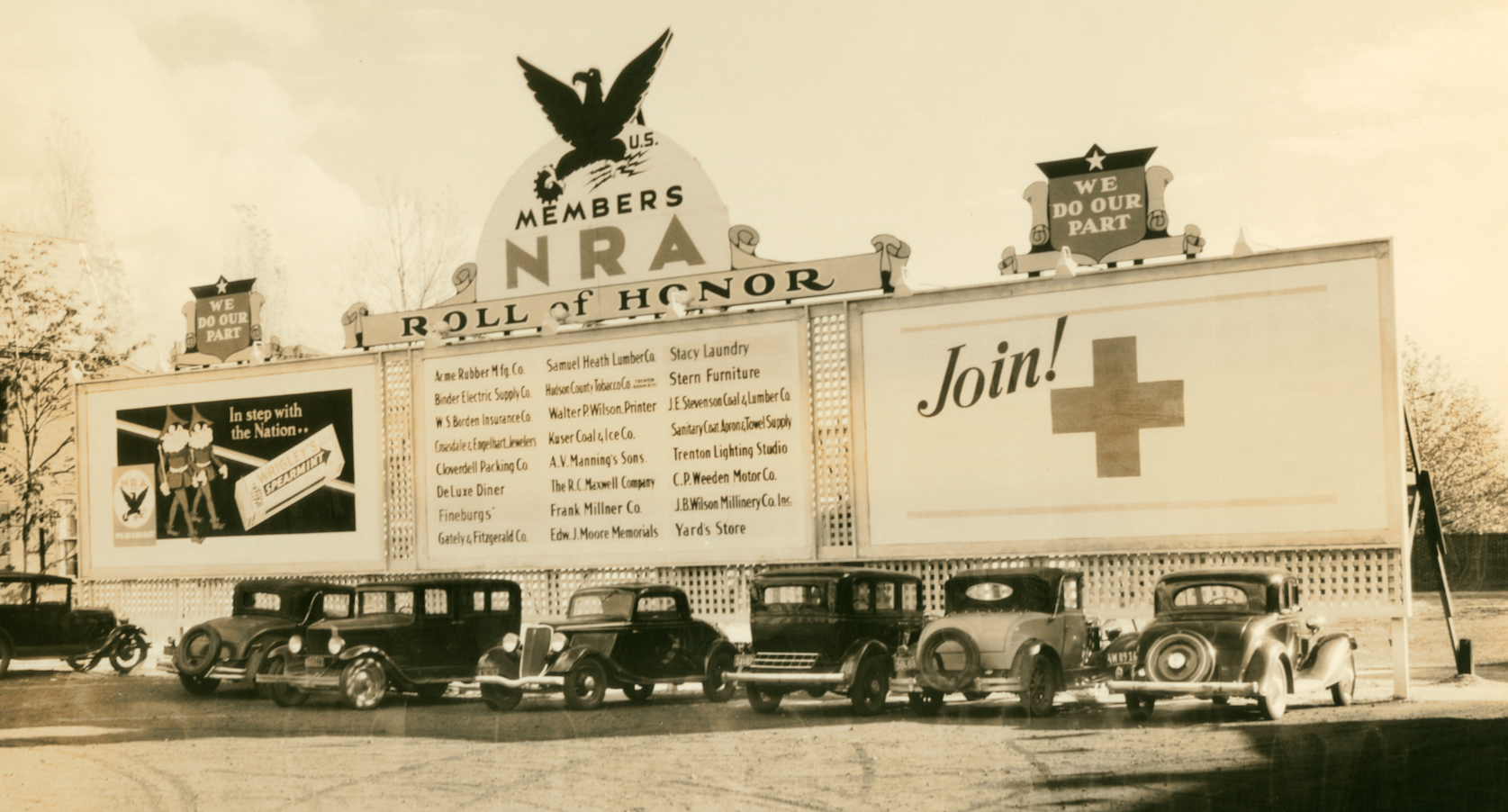 [A Wrigley ad on the left promotes the company’s support for the National Recovery Administration between 1933-1935]
[A Wrigley ad on the left promotes the company’s support for the National Recovery Administration between 1933-1935]
Sources:
The Home Front Encyclopedia, edited by James Ciment
“Philip K. Wrigley”– SABR.org
“William Wrigley Jr’s Formula For Success” by S.J. Duncan-Clark, Illustrated World, Vol. 37, March 1922
“The Wonder Story of Wrigley” by Merle Crowell, American Magazine, Vol. 89, 1920
Chicago and Its Resources 20 Years After (1871-1891), by Royal L. La Touche, John Henry Potter
Archived Reader Comments:
“I performed much maintenance work at wrigley gum factory on ashland as a union painter for national decorating out of oakdrook, IL, and the thing that remains with me during my times there is how Wrigley kept up the old building. They were always cleaning and putting on a fresh coat of paint everywhere; the company always kept up with this cleanliness and appearance of the buildings on ashland ave. i remember putting a coat of paint on even the most remote and unused parts of the factory. i remember working on weekends to put a coat of paint on their packaging machines for gum and cleaning out the giant vats where they mixed the various flavors of their products. i will always remember receiving gifts of gum as i walked out the door going home every evening.” — jeff acevedo, jefface8360@gmail.com

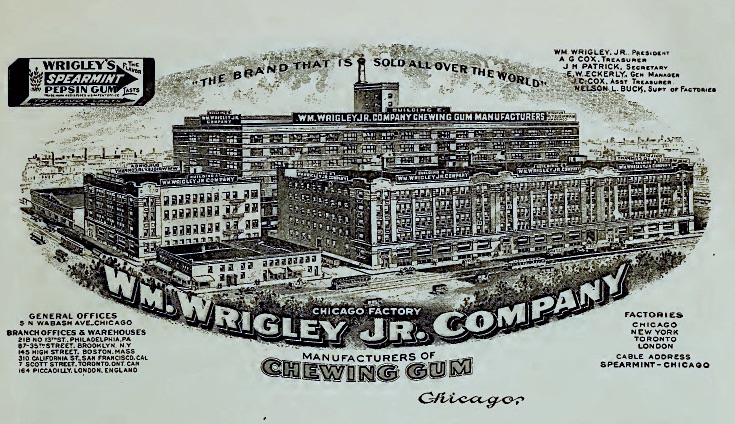
Would anyone hazard a guess on the value of a 20 pack of Doublemint gum, waxed paper label from the 50’s?
I have a obtained a case of gum 20 packs of 5 sticks it is dated 1974. It is very rare due to its misprint, its has the zipcode of only 4 numbers not 5 and the brand name on the package is SPEARDENT. was this product a mistake or was it put in productiom. Who would i contact .
Does anybody know more about the Wrigley’s Red Ale and the history of it. I have an old Beer sign that says “It’s a Hit” with a baseball player swinging, advertising’Red Ale’. I’m trying to figure out what decade it’s from. It’s hand painted on sheet metal.
In my mothers trunk I found a scrap book of about 20 pages of Fun Facts. Many have Fun Facts from Wrigley’s Spearmint Gun. Some pages as few as three and some as many as five pasted to the page. I do see dates of 1971 and 1973, Wm Wrigley Jr. Company on some and others just have a little BD2, BD20 in the corner.
Do you have a museum or is there a collector of Wrigley that might be interested in the scrap book?
My mother Charlotte Olesen 1950s made the Wrigley twins carasel and poodle skirts while their Aunt was her sewing teacher in high school. I am wondering if there is any photos you could email me for our family heritage?
I am the daughter.
I think Edward Wrigley who was William’s grandfather was born in Yorkshire UK.
Does anyone know where in Yorkshire he was born ?
What is the history of Wrigley’s Perfume? Found a small bottle with a purple and silver label with “Wm. Wrigley Jr & Co Chicago” written across the bottom.
Judy Johnson
I use to enjoy al flavors of Wrigley gum over the years.
But they have changed the formulas of the past and spoiled what it once tasted like. Blame the new owner for cutting cost.
I see now it was MARS candy co. that bought WRIGLY and destroyed the good old flavors of the past !
I have a vintage Orbit chewing gum wrapper that reads as follows:
Note: All of our prewar materials have been used up so there is no more WRIGLEY’S SPEARMINT – DOUBLEMINT or “JUICY FRUIT” being made. ORBIT is the best gum we can make now – it is pure and wholesome but not quite good enough to carry the WRIGLEY label. You may still get WRIGLEY brands but they will be older than ORBIT.
I’m not sure what year it is but very interesting all the same.
I have a Wm. Wrigley Jr. Co. Factory Parking Permit. It is number 8158. Orange in color still on the wax backing. Is your facility interested in this item?
When going through my late mother’s belongings we found a letter to her for her birthday from WM. Wrigley Jr. Company. Do you entertain the idea of purchasing this from our family to display in the Wrigley’s museum.
Tanya Jolley
I have 3 very old Stock Certificates from 1906 called “The Wrigley Co-Operative Plan” with $3,000,000 on top of each Stock Certificate. My 3 are:
01-20-1906 #45618 / 04-23-1906 #60579 / 08-03-1906 #106709.
The first 2 are 1 share and the last one is 3 shares and each says “is entitled to __ shares, $10 par value each in the Wrigley Co-Operative Plan on the conditions on back hereof.” Dated at Chicago, Ill. Each has red seal that says “CO-OPERATION AND SQUARE DEAL TO EVERYBODY”. The back of the first 2 read different from the last one, but all three fronts read the same. What was the Wrigley Co-Operative Plan history and conclusion? Thanks.
I have come across some (20 credit) united profit-sharing coupons. I can not find a value on the 20’s anywhere. would you be able to help me with value. they are in VG and Good condition.
Thankyou in Advance for your time. Duchess
I was so lucky to have been allowed to work for the Wrigley’s at their Ashland plant from 86 to 03. It was an uniquely very very profitable 19th century plant in a 21st century world. Sadly I saw the amazingly profitable company change, for no reason other than someone wanted it to change, from a progressive, supportive, sharing, home away from home, that if you were any kind of decent employee, made you feel involved and proud to be a part of. To a sterile, bleak, cold, unforgiving desert of a place with profit above all, It used people in the same way that we see so many firms do in the 2000’s. The process of that once glorious plant’s decay is emblematic of many issues we all currently face in this country.The sad, sad end of an era.
Dear Sir,
I am looking for the first advertising radio commercial that the Gun company Wrigley’s for make by the advertising agency BBDO in Chicago because the Jingle company Kent, Johnson in New york have make this radio Commercial and Can you help me on this record or do you have some emails from Collectors ?
I collecting radio jingles and Commercials for the Jingle industry for the last 35 years
Thanks you in advance for your help.
Albert Pleijsier
Holland
Some information about this Jingle company :
Eric Siday and Ginger Johnson start there company in 1954 there the introduced the first Logos for call letters , in 1948 Eric Siday make the first package’s for WWSW in Pittsburgh
National radio hit advertising jingle” “Nickel, Nickel Pepsi cola hit the spot” (1938) was written by Eric Siday who was paid $500,= for his efforts and ginger Johnson adapted from the tune of an 18th century English Hunting song titled “John Peel” Johnson would write early advertising jingles and then Siday would form the first electronic jingle company (Moog)
Interesting information.
I have three questions about the brand Wrigley Spearmint Gum, for the year 1910 or 1911:
1. Cost in NYC in March 1911?
2. in March of 1911 was the Spearmint label Pepsin or Perfect
3. Was there a coupon on wrapper in March 1911?
If you want to read a great book about the Art Deco designers of the Wrigley’s advertising, including gorgeous pictures, see “Dorothy and Otis: Designing the American Dream.”
It covers Wrigley’s Chewing Gum ads, Chicago Cubs designs and the marketing of the city of Avalon on Catalina Island, off the coast of Southern California.
Just happened to come across this article as I watch them tear down the remainder of the Wrigley factory on 35th and Ashland will try and send a pic today 5/8/2020